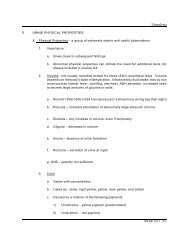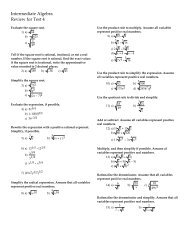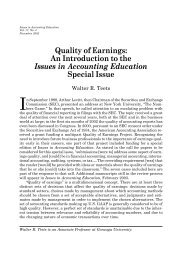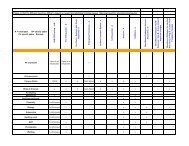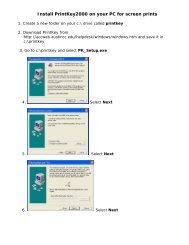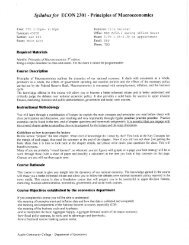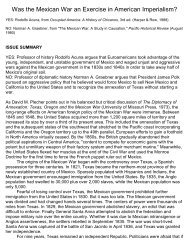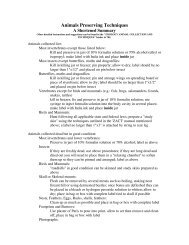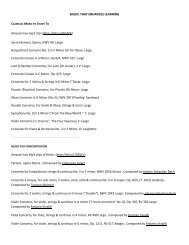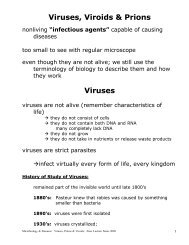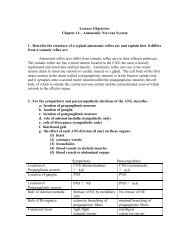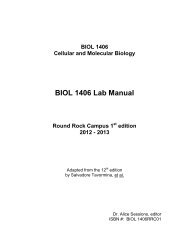Circulation/Transport The Circulatory System
Circulation/Transport The Circulatory System
Circulation/Transport The Circulatory System
Create successful ePaper yourself
Turn your PDF publications into a flip-book with our unique Google optimized e-Paper software.
<strong>Circulation</strong>/<strong>Transport</strong><br />
General<br />
two major transport systems in body:<br />
A. <strong>The</strong> <strong>Circulatory</strong> <strong>System</strong><br />
B. <strong>The</strong> Lymphatic Sysem<br />
circulatory system works in conjunction with<br />
lymphatic system<br />
! they are directly connected to each other<br />
A. <strong>Circulatory</strong> (cardiovascular) <strong>System</strong><br />
circulatory system consists of “plumbing” and<br />
“pumps” & circulating fluid<br />
pump = the heart<br />
fluid = blood<br />
blood flows in closed system of vessels<br />
over 60,000 miles of vessels (mainly capillaries)<br />
>arteries ! capillaries ! veins<br />
heart<<br />
arteries & arterioles<br />
– take blood away from heart to capillaries<br />
Human Anatomy & Physiology: <strong>Circulatory</strong> <strong>System</strong>, Ziser Lecture Notes, 2010.4 1<br />
<strong>The</strong> <strong>Circulatory</strong> <strong>System</strong><br />
(Cardiovascular <strong>System</strong>)<br />
major connection between external and internal<br />
environment:<br />
everything going in or out of body must go through<br />
the circulatory system to get to where its going<br />
more than 60,000 miles of blood vessels with a pump<br />
that beats 100,000 times each day<br />
General Functions of <strong>Circulatory</strong> <strong>System</strong>:<br />
A. <strong>Transport</strong><br />
B. Homeostasis<br />
C. Protection<br />
A. <strong>Transport</strong> functions:<br />
1. Pick up food and oxygen from digestive and<br />
respiratory systems and deliver them to cells<br />
2. pick up wastes and carbon dioxide from cells and<br />
deliver to kidneys and lungs<br />
3. <strong>Transport</strong> hormones & other chemicals, enzymes etc<br />
throughout the body<br />
B. Homeostasis functions:<br />
Human Anatomy & Physiology: <strong>Circulatory</strong> <strong>System</strong>, Ziser Lecture Notes, 2010.4 3<br />
capillaries<br />
-actual site of exchange<br />
venules & veins<br />
– bring blood from capillaries back to heart<br />
B. Lymphatic <strong>System</strong><br />
an open system that returns excess materials<br />
in the tissue spaces back to the blood<br />
fluid = lymph<br />
no dedicated pump; muscle contractions<br />
move lymph along<br />
lymphatic vessels move lymph in one<br />
direction; lymph does not circulate<br />
Human Anatomy & Physiology: <strong>Circulatory</strong> <strong>System</strong>, Ziser Lecture Notes, 2010.4 2<br />
4. maintain fluid and electrolyte balances in tissues and<br />
cells<br />
5. maintain acid/base balances in tissues and cells<br />
6. help regulate temperature homeostasis<br />
transfers excess heat from core to skin for removal<br />
C. Protective Functions:<br />
7. Clotting and Inflammation prevent excessive<br />
fluid loss and limit the spread of infection<br />
8. Circulating cells and chemicals actively seek out<br />
and remove pathogens from the body<br />
= “immune system”<br />
Human Anatomy & Physiology: <strong>Circulatory</strong> <strong>System</strong>, Ziser Lecture Notes, 2010.4 4
<strong>The</strong> Heart – Anatomy<br />
we are more aware of our heart than most other<br />
internal organs<br />
Some ancient Chinese, Egyptian, Greek and Roman scholars correctly<br />
surmised that the heart is a pump for filling vessels with blood<br />
Aristotle however thought the heart was the seat of emotion and a<br />
source of heat to aid digestion:<br />
excited ! heart beats faster<br />
“heartache” of grief<br />
his thoughts predominated for over 2000 years before its true<br />
nature reemerged<br />
the heart is one of first organ systems to appear in<br />
developing embryo<br />
! heart is beating by 4 th week<br />
study of heart = cardiology<br />
no machine works as long or as hard as your heart<br />
beats: >100,000 x’s/day<br />
> 30 Million times each year<br />
> 3 Billion times in a lifetime to pump > 1 Million barrels<br />
of blood<br />
heart is about size and shape of closed fist<br />
heart lies behind sternum in mediastinum<br />
broad superior border of heart = base<br />
Human Anatomy & Physiology: <strong>Circulatory</strong> <strong>System</strong>, Ziser Lecture Notes, 2010.4 5<br />
[endocarditis]<br />
Heart Chambers<br />
interior of heart is subdivided into 4 chambers:<br />
atria = two upper chambers<br />
with auricles<br />
smaller, thinner, weaker<br />
ventricles = two lower chambers<br />
larger, thicker, stronger<br />
left ventricle much larger and thicker than<br />
right ventricle<br />
Heart Vessels<br />
left ventricle is at apex of heart<br />
<strong>The</strong>re are 4 major vessels attached to heart:<br />
2 arteries (take blood away from heart):<br />
aorta<br />
- from left ventricle<br />
pulmonary trunk<br />
- from right ventricle<br />
2 veins (bring blood back to heart):<br />
vena cava (superior & inferior)<br />
- to right atrium<br />
Human Anatomy & Physiology: <strong>Circulatory</strong> <strong>System</strong>, Ziser Lecture Notes, 2010.4 7<br />
lower border of heart (=apex) lies on diaphragm<br />
heart is enclosed in its own sac, = pericardium<br />
(=pericardial sac)(parietal pericardium)<br />
composed of tough fibrous outer layer and inner<br />
serous membrane<br />
outer surface of heart is also covered with serous<br />
membrane (= visceral pericardium)<br />
(=epicardium) continuous with the pericardium<br />
between the 2 membranes is pericardial fluid<br />
!lubrication<br />
wall of heart:<br />
pericarditis = inflammation of pericardium,<br />
membranes become dry, each heartbeat becomes<br />
painful<br />
epicardium = visceral pericardium<br />
thin & transparent serous tissue<br />
myocardium = cardiac muscle cell<br />
most of heart<br />
branching, interlacing contractile tissue<br />
acts as single unit (gap junctions)<br />
endocardium = delicate layer of endothelial cells<br />
continuous with inner lining of blood vessels<br />
Human Anatomy & Physiology: <strong>Circulatory</strong> <strong>System</strong>, Ziser Lecture Notes, 2010.4 6<br />
Heart Valves<br />
pulmonary veins (4 in humans)<br />
- to left atrium<br />
<strong>The</strong>re are also 4 one-way valves that direct flow of<br />
blood through the heart in one direction:<br />
2 Atrioventricular (AV) valves<br />
bicuspid (Mitral) valve<br />
- separates left atrium and ventricle<br />
- consists of two flaps of tissues<br />
tricuspid valve<br />
- separates right atrium and ventricle<br />
- consists of three flaps of tissues<br />
both held in place by chordae tendinae<br />
attached to papillary muscles<br />
! prevent backflow (eversion)<br />
keeps valves pointed in direction of flow<br />
2 Semilunar valves<br />
at beginning of arteries leaving the ventricles<br />
aortic SL valve<br />
at beginning of aorta<br />
pulmonary SL valve<br />
at beginning of pulmonary trunk<br />
Human Anatomy & Physiology: <strong>Circulatory</strong> <strong>System</strong>, Ziser Lecture Notes, 2010.4 8
Blood Vessels<br />
blood flows in closed system of vessels:<br />
arteries, capillaries & veins<br />
(over 60,000 miles of vessels (mainly capillaries)<br />
Histology of Vessels<br />
walls of arteries and veins consist of three layers:<br />
a. Tunica Externa<br />
b. Tunica Media<br />
c. Tunica Interna<br />
a. Tunica Externa (= T. adventitia)<br />
outer loose connective tissue<br />
anchors the vessel and provides passage for small<br />
nerves, lymphatic vessels and smaller blood<br />
vessels<br />
b. Tunica Media<br />
middle, made mainly of smooth muscle with some<br />
elastic tissue and collagen fibers<br />
strengthens vessel walls<br />
! prevent high pressure from rupturing them<br />
Human Anatomy & Physiology: <strong>Circulatory</strong> <strong>System</strong>, Ziser Lecture Notes, 2010.4 9<br />
Kinds of Blood Vessels<br />
1. Arteries & Arterioles<br />
built to withstand the greatest pressure of the<br />
system<br />
!strong resilient walls<br />
!thick layers of connective tissues<br />
!more muscular than veins<br />
arteries and arterioles typically contain ~25% of<br />
all blood in circulation<br />
2. Veins & Venules<br />
generally have a greater diameter than arteries<br />
but thinner walls, flaccid<br />
! more compliant<br />
three layer are all thinner than in arteries<br />
tunica adventitia is thickest of three<br />
but not as elastic as arteries<br />
little smooth muscle<br />
veins function to collect blood and act as blood<br />
reservoirs<br />
~70% of all blood is in veins & venules<br />
Human Anatomy & Physiology: <strong>Circulatory</strong> <strong>System</strong>, Ziser Lecture Notes, 2010.4 11<br />
allows vasodilation and vasoconstriction<br />
usually the thickest layer, especially in arteries<br />
c. Tunica Interna (=T. Intima)<br />
inner endothelium<br />
exposed to blood<br />
acts as semipermeable membrane to materials<br />
entering and leaving the blood<br />
secretes chemicals that stimulate the muscles of<br />
vessel wall to contract or relax<br />
when damaged or inflamed induce platelets or<br />
WBC’s to adhere<br />
! may lead to plaque buildup and atherosclerosis<br />
aneurysm = a weak point in arterial wall forms<br />
Is a bulging sac that may rupture or put pressure on nearby<br />
brain tissue, vessels or other passageways.<br />
usually due to degeneration of the tunica media,<br />
atherosclerosis or hypertension<br />
Most common in abdominal aorta, renal arteries and<br />
circle of Willis<br />
Human Anatomy & Physiology: <strong>Circulatory</strong> <strong>System</strong>, Ziser Lecture Notes, 2010.4 10<br />
3. Capillaries:<br />
actual site of exchange of materials<br />
! the rest is pumps and plumbing<br />
thin walled - single cell layer thick<br />
extremely abundant in almost every tissue of body<br />
!most of 62,000 miles of vessels<br />
each capillary .1 mm away from a capillary<br />
arranged into capillary beds<br />
= functional units of circulatory system<br />
5% of blood at any one time<br />
Circuits of Bloodflow<br />
general route of blood flow:<br />
heart!arteries!capillaries!veins!heart<br />
arteries, capillaries and veins are arranged into two<br />
circuits:<br />
Human Anatomy & Physiology: <strong>Circulatory</strong> <strong>System</strong>, Ziser Lecture Notes, 2010.4 12
pulmonary: heart ! lungs ! heart<br />
rt ventricle! pulmonary arteries (trunk)!lungs!pulmonary<br />
veins!left atrium<br />
systemic: heart ! rest of body ! heart<br />
left ventricle!aorta!body!vena cava!rt atrium<br />
heart is a double pump<br />
oxygen deficient blood in pulmonary vein and vena cava<br />
! usually blue on models<br />
Human Anatomy & Physiology: <strong>Circulatory</strong> <strong>System</strong>, Ziser Lecture Notes, 2010.4 13<br />
Special <strong>Circulation</strong> Patterns<br />
1. Coronary <strong>Circulation</strong> (or Cardiac <strong>Circulation</strong>)<br />
heart needs an abundant supply of oxygen and<br />
nutrients<br />
!myocardium has its own supply of vessels<br />
~5% of blood goes to heart muscle tissue<br />
~10-x’s its “fair share” based on weight alone<br />
any interruption of blood flow can cause<br />
necrosis within minutes<br />
= myocardial infarction<br />
R & L Coronary Artery branch from aorta just<br />
beyond aortic SL valve<br />
most blood returns to heart through veins<br />
that drain into coronary sinus<br />
which empties into Right Atrium beneath entrance<br />
of Inferior Vena Cava<br />
2. Circle of Willis<br />
7 separate arteries<br />
branchig from the internal carotids and<br />
vertebral arteries<br />
arterial anastomosis interconnects them to form a<br />
Human Anatomy & Physiology: <strong>Circulatory</strong> <strong>System</strong>, Ziser Lecture Notes, 2010.4 15<br />
Anatomy of <strong>Circulatory</strong> <strong>System</strong><br />
Major Arteries and Veins<br />
Pulmonary Circuit:<br />
Arteries pulmonary trunk to pulmonary a.<br />
Veins pulmonary v.<br />
<strong>System</strong>ic Circuit:<br />
Arteries aorta<br />
ascending aorta<br />
rt & lft coronary a.<br />
aortic arch<br />
brachiocephalic a.<br />
common carotid a.<br />
internal carotid a.<br />
external carotid a.<br />
subclavian a.<br />
axillary a.<br />
brachial a.<br />
lft common carotid a.<br />
lft subclavian a<br />
descending aorta<br />
celiac trunk<br />
superior mesenteric a.<br />
renal a.<br />
gonadal a.<br />
inferior mesenteric a.<br />
common iliac a.<br />
internal iliac a.<br />
external iliac a.<br />
femoral a.<br />
Veins: superior vena cava<br />
coronary v.<br />
brachiocephalic v.<br />
jugular v.<br />
subclavian v.<br />
axillary v.<br />
brachial v.<br />
inferior vena cava<br />
hepatic v.<br />
hepatic portal v.<br />
superior mesenteric v.<br />
inferior mesenteric v.<br />
renal v.<br />
gonadal v.<br />
common iliac v.<br />
internal iliac v.<br />
external iliac v.<br />
femoral v.<br />
Human Anatomy & Physiology: <strong>Circulatory</strong> <strong>System</strong>, Ziser Lecture Notes, 2010.4 14<br />
circle of connecting arteries at base of brain<br />
! more than one route for blood to get to<br />
brain<br />
3. Hepatic Portal <strong>System</strong><br />
veins from spleen, stomach, pancreas, gall<br />
bladder, and intestines<br />
superior and inferior mesenteric merge to form<br />
hepatic portal vein<br />
do not take blood directly to vena cava<br />
instead take it to liver for “inspection”<br />
-phagocytic cells remove toxins<br />
-vitamins and minerals are stored<br />
Human Anatomy & Physiology: <strong>Circulatory</strong> <strong>System</strong>, Ziser Lecture Notes, 2010.4 16
Heart Physiology<br />
for the heart to work properly contraction and<br />
relaxation of chambers must be coordinated<br />
Histology of Heart<br />
cardiac muscle fibers (=cardiocytes)<br />
relatively short, thick branched cells,<br />
50-100 !m long<br />
rather than tapering cells are bluntly attached to each<br />
other by gap junctions = intercalated discs<br />
! myocardium behaves as single unit<br />
but atrial muscles separated from<br />
ventricular muscles by conducting tissue<br />
sheath<br />
! atria contract separately from<br />
ventricles<br />
cardiac muscle cells cannot stop contracting to build up<br />
glycogen stores for anaerobic metabolism<br />
! need constant supply of oxygen & nutrients to<br />
remain aerobic<br />
! greater dependence on oxygen than skeletal<br />
Human Anatomy & Physiology: <strong>Circulatory</strong> <strong>System</strong>, Ziser Lecture Notes, 2010.4 17<br />
AV Bundle (Bundle of His)<br />
connected to AV Node<br />
takes stimulus from AV Node to ventricles<br />
Purkinje Fibers<br />
takes impulse from AV Bundle out to cardiac mucscle fibers<br />
of ventricles causing ventricles to contract<br />
the heart conducting system generates a small<br />
electrical current that can be picked up by an<br />
electrocardiograph<br />
=electrocardiogram (ECG; EKG)<br />
ECG is a record of the electrical activity of the<br />
conducting system<br />
ECG is NOT a record of heart contractions<br />
R<br />
P T<br />
Q S<br />
P wave = passage of current through atria<br />
from SA Node<br />
QRS wave = passage of current through<br />
ventricles from AV Node – AV Bundle –<br />
Purkinje Fibers<br />
T wave = repolarization of ventricles<br />
by comparing voltage amplitudes and time intervals<br />
between these waves from several leads can get<br />
Human Anatomy & Physiology: <strong>Circulatory</strong> <strong>System</strong>, Ziser Lecture Notes, 2010.4 19<br />
muscles<br />
! can’t build up much oxygen debt<br />
have exceptionally large mitochondria<br />
comprise 25% of cell volume (vs skeletal mm!2%)<br />
cells are more adaptable in nutrient use; can use:<br />
glucose<br />
fatty acids (preferred)<br />
lactic acid<br />
Conducting <strong>System</strong><br />
cardiac muscle cells are not individually innervated as<br />
are skeletal muscle cells<br />
!they are self stimulating<br />
the rhythmic beating of the heart is coordinated and<br />
maintained by the heart conducting system<br />
conducting system consists of:<br />
SA Node<br />
intrinsic rhythm<br />
70-75 beats/min<br />
initiates stimulus that causes atria to contract<br />
(but not ventricles directly due to separation)<br />
AV Node<br />
picks up stimulus from SA Node<br />
if SA Node is not functioning it can act as a pacemaker<br />
=ectopic pacekmaker (usually slower intrinsic rhythm)<br />
Human Anatomy & Physiology: <strong>Circulatory</strong> <strong>System</strong>, Ziser Lecture Notes, 2010.4 18<br />
idea of how rapidly the impulses are being<br />
conducted and how the heart is functioning<br />
Abnormalities of ECG’s = arrhythmias<br />
1. bradycardia (100 bpm)<br />
increased body temperature ! fever<br />
emergencies, stress activation of sympathetic NS<br />
some drugs<br />
may promote fibrillation<br />
4. fibrillation<br />
rapid, uncoordinated contractions of individual muscle cells<br />
ventricular fibrillation is lethal<br />
electrical shock used to defibrillate and recoordinate<br />
contractions<br />
5. AV Node Block<br />
Cardiac Cycle<br />
1 complete heartbeat (takes ~ 0.8 seconds)<br />
consists of:<br />
systole ! contraction of each chamber<br />
diastole ! relaxation of each chamber<br />
Human Anatomy & Physiology: <strong>Circulatory</strong> <strong>System</strong>, Ziser Lecture Notes, 2010.4 20
two atria contract simultaneously<br />
as they relax, ventricles contract<br />
relation of ECG to cardiac cycle<br />
contraction and relaxation of ventricles produces<br />
characteristic heart sounds: lub-dub<br />
lub = systolic sound<br />
contraction of ventricles and closing of<br />
AV valves<br />
dub = diastolic sound<br />
shorter, sharper sound<br />
ventricles relax and SL valves close<br />
abnormal sounds: “murmurs”<br />
! defective valves<br />
congenital<br />
rheumatic (strep antibodies)<br />
septal defects<br />
Cardiac Output<br />
=<strong>The</strong> amount of blood that the heart pumps/min<br />
CO = Heart Rate X Stroke volume<br />
= 75b/m X 70ml/b<br />
= 5250 ml/min (=5.25 l/min)<br />
~ normal blood volume<br />
during strenuous exercise heart may increase<br />
output 4 or 5 times this amount<br />
Human Anatomy & Physiology: <strong>Circulatory</strong> <strong>System</strong>, Ziser Lecture Notes, 2010.4 21<br />
Physiology of Blood Vessels<br />
Blood circulates by going down a pressure gradient<br />
! to understand circulation we must understand<br />
blood pressure<br />
Blood Pressure<br />
=the force of the blood flowing through<br />
blood vessels<br />
measured as mmHg [ 100 mm Hg = 2 psi, tire ~35psi]<br />
changes in pressure are the driving force that moves<br />
blood through the circulatory system<br />
blood pressure is created by<br />
1. the force of the heart beat<br />
previously discussed<br />
the heart maintains a high pressure on the<br />
arterial end of the circuit<br />
2. peripheral resistance<br />
! back pressure, resistance to flow<br />
mainly depends on diameter of a vessel and<br />
its compliance<br />
Human Anatomy & Physiology: <strong>Circulatory</strong> <strong>System</strong>, Ziser Lecture Notes, 2010.4 23<br />
A. Heart Rate:<br />
innervated by autonomic branches to SA and AV<br />
nodes (antagonistic controls)<br />
cardiac control center in medulla (cardiac center)<br />
B. Stroke Volume:<br />
healthy heart pumps ~60% of blood in it<br />
!normal SV = ~70 ml<br />
affected mainly by mean arteriole pressure<br />
systemic blood pressure =back pressure<br />
and the condition of heart tissue<br />
eg. heart contractility, fibrosis<br />
indicates amt of damage<br />
Human Anatomy & Physiology: <strong>Circulatory</strong> <strong>System</strong>, Ziser Lecture Notes, 2010.4 22<br />
most resistance to blood flow is found in the<br />
arterioles<br />
also, any blockage of the normal diameter of a<br />
vessel will increase resistance<br />
eg atherosclerosis inhibits flow<br />
! raises blood pressure<br />
Measuring Blood Pressure<br />
use sphygmomanometer<br />
usually measure pressure in the brachial artery<br />
procedure:<br />
a. increase pressure above systolic to<br />
completely cut off blood flow in artery<br />
b. gradually release pressure until 1 s t spurt<br />
(pulse) passes through cuff<br />
= systolic pressure<br />
c. continue to release until there is no<br />
obstruction of flow<br />
sounds disappear<br />
= diastolic pressure<br />
normal BP = 120/80<br />
range: 110-140 / 75-80 [mm Hg]<br />
top number = systolic pressure<br />
Human Anatomy & Physiology: <strong>Circulatory</strong> <strong>System</strong>, Ziser Lecture Notes, 2010.4 24
force of ventricular contraction<br />
bottom number = resistance of blood flow<br />
may be more important<br />
indicates strain to which vessels are<br />
continuously subjected<br />
also reflects condition of peripheral vessels<br />
Abnormal Blood Pressure<br />
Hypotension<br />
low BP ! systolic
after capillaries branch off)<br />
capillaries branch from metarterioles<br />
1-100/bed<br />
cuff of smooth muscle surrounds origin of capillary<br />
branches<br />
= precapillary sphincter<br />
amount of blood entering a bed is regulated by:<br />
a. vasomotor nerve fibers<br />
b. local chemical conditions<br />
Human Anatomy & Physiology: <strong>Circulatory</strong> <strong>System</strong>, Ziser Lecture Notes, 2010.4 29<br />
results: quick move from lying to standing, blood<br />
is drawn away from brain, can cause dizziness<br />
or fainting<br />
Human Anatomy & Physiology: <strong>Circulatory</strong> <strong>System</strong>, Ziser Lecture Notes, 2010.4 31<br />
Effects of Aging on CV <strong>System</strong><br />
most noticeable effect of aging on CV system is<br />
stiffening of arteries<br />
heart has to work harder to overcome resistance<br />
ventricles enlarge, esp left ventricle<br />
may get so thick that not enough space to pump<br />
blood effectively<br />
valves may thicken and become calcified<br />
impulse conduction along conducting system becomes<br />
more difficult<br />
!increase in arrhythmias or heart block<br />
muscle cells die<br />
heart becomes weaker<br />
!lower tolerance to physical activity<br />
Atherosclerosis is main change seen in blood vessels<br />
with age<br />
stiffening of arterial walls with increasing deposits<br />
of collagen fibers & declining resilience of elastic<br />
fibers<br />
also decline in responsiveness of baroreceptors so less<br />
vasomotor response to changes in blood pressure<br />
Human Anatomy & Physiology: <strong>Circulatory</strong> <strong>System</strong>, Ziser Lecture Notes, 2010.4 30<br />
Disorders of the <strong>Circulatory</strong> <strong>System</strong><br />
Heart Disease<br />
can lead to heart attack and ultimately heart failure<br />
leading cause of death in US for both men and women<br />
! 500,000 deaths/yr 7.2 M/yr worldwide (’07)<br />
! 30% of deaths/yr<br />
most common form is coronary atherosclerosis<br />
often leading to myocardial infarction (heart attack)<br />
Heart Attack<br />
heart attack risk is ~’50% genetic & 50% cheeseburger’<br />
begins with the buildup of plaque:<br />
a. cholesterol in blood infiltrates the arterial wall<br />
b. immune system dispatches macrophages to consume the<br />
cholesterol<br />
c. macrophages become foam cells full of cholesterol<br />
d. foam cells accumulate and become a major component of<br />
plaque<br />
e. to keep the arterial wall slick, smooth muscle cells form a<br />
cap<br />
f. foam cells in plaque secrete chemicals that weaken the cap<br />
g. f the cap cracks, plaque seeps into the blood stream and<br />
a clot forms that blocks bloodflow<br />
Abnormal Blood Pressure<br />
Human Anatomy & Physiology: <strong>Circulatory</strong> <strong>System</strong>, Ziser Lecture Notes, 2010.4 32
Hypotension<br />
low BP ! systolic



